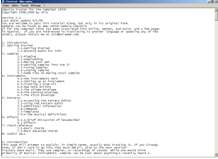
 |
We
use the Modplug Tracker, the sort-of-modern
version of the ancestors of all audio programs i.e. trackers. Famous
historical trackers include: OctaMed and Protracker for Amiga, Merlin
for Atari, Fast Tracker and Impulse Tracker for DOS. A tracker is a
sampler/sequencer program. Trackers were originally developped back
in the late 80s to create musical backgrounds for the quite basic videogames
that came on the 500kb floppydisks of that time. Since the room on a
floppydisk is sparse and the resources on an Amiga (although being quite
amazing) seem very primitive today, the format had to be tidy and SMALL.
|
What we mean by SMALL is actually VERY DAMN *S*M*A*L*L*, most
of the files being less than 20 kb for 2-3 minutes of music (this is
because trackers use very low bitrate and samplerate files in a very
clever way -in fact programming a tracker the way it was designed to
be is very funny and entertaining because of this). Compared to today's
programs, trackers provide a real amusement -maybe the reason why some
people still use them is the exact reason some people still play Asteroids
or 1942, because it's just fun. A soundfile created with a tracker (it's
called a module) can be directly played by most modern mp3 players such
as Winamp or Sonique because their formats are the oldest around (although
you'll find The Modplug Player
gives a more accurate reproduction). Many resources exist over the internet
for tracker programs. Here's one good start
and another one. You have the Tracking
Bible here. |
 |
These words were mostly taken from "the trackers' handbook" the Tracking Bible we were just speaking of: A tracker is a piece of software that allows music to be made using only a computer and some sound samples. These sound samples are then played back at varying pitches and with various effects so as to produce music. The musical data used to describe how to play each note is arranged in a list like form. This data scrolls up the screen, and when it passes the cursor it gets processed and played. Trackers produce files called modules, which is usually abbreviated to MOD. |
The
term MOD originally meant a file created with the SoundTracker software,
but over the years it has become a generic term for any type of module.
MODs are a sort of hybrid MIDI/sample file. They contain sequencing
information as well as the instruments (samples) that are used for playback.
It's actually quite hard to give trackers and MODs a 'definition' that
can be understood by everyone. If you have Internet access then do a
search for 'MOD Trackers' and quite a number of definitions should pop
up.
Choosing a tracker to begin with is probably the most important choice you can make as you start out, some trackers have extremely difficult interfaces to learn. Which, if you are only just starting out and have never used a tracker before, pose an extra challenge that will need to be undertaken. There are six
systems with trackers that I know of, classified as - Obviously the system you own dictates what you can use, but the Amiga, Atari, and Mac based trackers are split up into a few different areas, depending on your hardware. Whatever tracker you decide on using, before you even start tracking with it, be sure to read the manual. Load a few already made modules in so you can play around with the various features and find out how they work. Spend a day figuring out every feature of the tracker. The only way to find out what tracker is best for you is to try out a few and then decide. I would recommend that you choose a tracker that produces a standard module format for the platform you are producing on e.g. if you own an Amiga a MOD based tracker would be a good choice, on a PC an IT or XM tracker would be a good choice etc. Don't use a tracker just because someone else does, or because it offers more features. Choose a tracker for its interface every time. There's no point having something hugely powerful but not being able to use it. |
 |
These lines are taken from "impulse tracker for the compleat idiot" (a funny title, cause given the complexity of IT, it surely requires a lot of IQ points to operate), they're a little more straightforward: Trackers make music! They use samples, or recordings of sounds. While one would think primarily of musical instruments, samples can be just about anything-I recently heard a module that used the sound of a hairdryer! Module, by the way, is one of the words used to describe a piece of music made by a tracker. There are quite a few different trackers available, but I will be talking about the Impulse Tracker because that's the one I use. |
These sounds are arranged in patterns. Every song has patterns, or sections that repeat themselves. As an example, we'll use "Mary Had A Little Lamb":
|